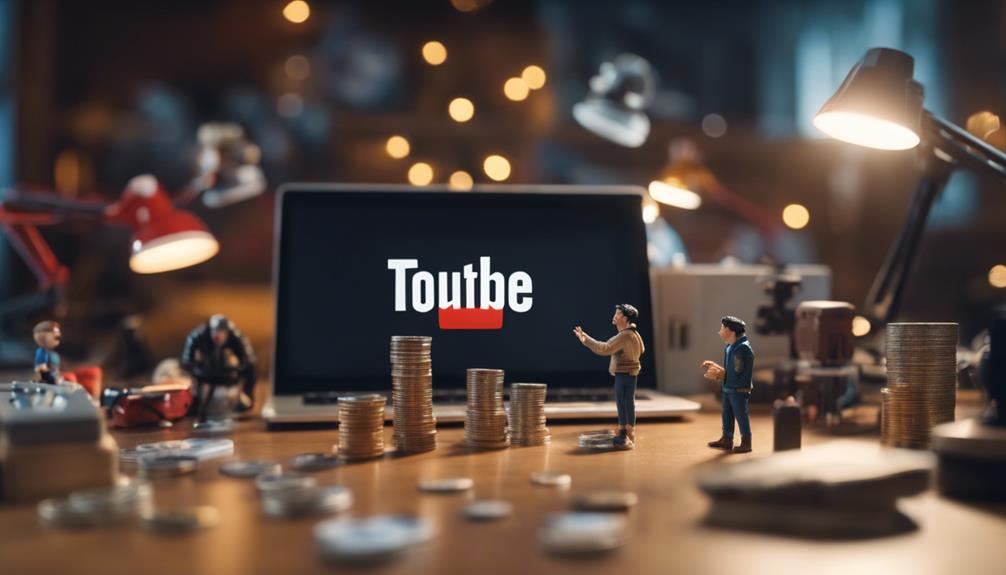
How much does YouTube pay?
Imagine a river, its streams representing the various revenue sources that converge into the mighty earnings potential of YouTube.
You’re sitting on the bank, wondering how much YouTube really pays. It’s not as simple as you might think; factors like ad revenue, video views, audience demographics, and more all play a part.
But how do these streams flow together, and what does it mean for your potential earnings?
Let’s set sail on this intriguing journey, and you might just find the answers you’re after.
Key Takeaways
- YouTube pays through ad revenue, channel memberships, YouTube Premium, Super Chat, and Merchandise Shelf.
- Earnings vary based on audience demographics, views, engagement, and content strategy.
- Diversifying revenue sources aids in maintaining steady income streams.
- YouTube’s payment threshold and various features can significantly impact a creator’s earnings.
Understanding YouTube Monetization

To fully grasp how much YouTube pays, you need to dive into the intricacies of YouTube monetization, which is a strategic process based on numerous data-driven factors. Monetization policies play a significant role in determining your earnings. These policies aren’t static; they evolve, keeping pace with viewer behaviors, advertiser preferences, and broader societal norms. It’s essential to keep abreast of these changes and adapt your content strategy accordingly.
Speaking of content strategy, it’s not merely about creating engaging videos. It’s about crafting a smart, data-driven strategy centered around YouTube’s monetization guidelines. You need to understand what type of content attracts advertisers, as well as the kind of content that YouTube’s algorithms promote. You’ve got to strike a balance between creative expression and revenue optimization.
Moreover, remember that YouTube monetization isn’t a one-size-fits-all model. It’s a dynamic, complex system that rewards creativity, innovation, and strategic thinking. It’s about leveraging data and insights to drive your content forward. In a nutshell, understanding YouTube’s monetization policies and crafting a robust content strategy are key to unlocking the potential of YouTube’s payment system.
The Role of Ad Revenue
In earning from YouTube, ad revenue plays a crucial role, and understanding its dynamics can significantly boost your earnings. It’s more than just allowing ads to play before your videos. It’s about strategically leveraging the various avenues of ad revenue generation.
Here’s a quick breakdown:
- Pre-Roll Ads: These are the ads that play before your video starts. They can be skipped after a few seconds, but even if they are, you still earn.
- Banner Ads: These ads appear at the bottom of your video. They’re less intrusive, but the earnings are also modest.
- Ad Blocker Impact: The use of ad blockers can significantly reduce your ad revenue. It’s important to find innovative ways to engage your audience without relying solely on ad revenue.
- Sponsored Content Opportunities: Partnering with brands for sponsored content can be a lucrative revenue stream. It’s about creating content that seamlessly integrates the sponsor’s message while still providing value to your audience.
Importance of Video Views

While maximizing ad revenue is crucial, it’s your video views that truly underpin your earning potential on YouTube. More views mean more chances for viewer engagement and ad exposure, which directly correlates to increased revenue. It’s a numbers game; more eyeballs on your content translate to more money in your pocket.
But it’s not just about racking up views; video optimization plays a massive role in your success. By tailoring your content to be easily discoverable, you’re essentially casting a wider net to capture potential viewers. This includes strategic keyword usage, compelling titles and descriptions, and effective use of tags.
Viewer engagement, too, can significantly boost your visibility. Likes, comments, shares, and watch time all factor into YouTube’s algorithm, meaning videos that trigger more interaction will be more likely to appear in searches and recommendations.
Impact of Audience Demographics
Understanding your audience demographics isn’t just useful, it’s critical for maximizing your YouTube earnings. Demographic targeting allows you to tailor your content to the tastes and preferences of your audience, thus increasing the appeal and, consequently, your potential earnings.
Here’s the impact of audience demographics on your YouTube earnings:
- Demographic targeting: By understanding who your audience is, you can create content that resonates with them. This increases engagement and, ultimately, your ad revenue.
- Viewer’s purchasing power: The purchasing power of your audience directly influences the types of ads shown on your videos. Higher income audiences attract premium ads, which pay more.
- Geographical location: Audiences from different countries have different CPM (Cost Per Mille) rates. For example, views from countries like the US, UK, Canada tend to have higher CPM rates.
- Age and Gender: These factors can influence the types of products or services advertisers want to promote on your channel, affecting the ads you attract and their corresponding rates.
Channel Memberships and Earnings

Beyond leveraging your audience demographics to increase ad revenue, you can also boost your earnings through channel memberships, a powerful tool that offers multiple benefits. By offering channel memberships, you’re crafting a premium experience for your subscribers. This not only enhances user engagement but also leads to a steady income stream.
Strategically, channel memberships can unlock lucrative sponsorship deals. Companies are constantly seeking innovative ways to reach their target market, and sponsoring a popular YouTube channel is an appealing prospect. It’s a win-win situation: you gain a sponsor’s financial support, and their brand reaches your loyal subscribers.
Moreover, consider integrating Patreon support into your monetization strategy. Patreon is a platform that allows fans to directly fund creators they love. By offering exclusive content or perks on Patreon, you can cultivate a community of devoted supporters who are willing to pay for your unique content. This can significantly increase your earnings.
YouTube Premium and Its Perks
Let’s shift our focus to YouTube Premium, a subscription service that offers numerous advantages.
We’ll break down the features it provides and conduct a thorough cost-benefit analysis.
This approach will allow you to evaluate whether the perks outweigh the investment, from an economic standpoint.
Premium Features Overview
Diving into the premium features, YouTube Premium offers an ad-free experience, background play, access to YouTube Originals, and the ability to download videos for offline viewing, thus adding significant value to your viewing experience. This strategic move not only enhances user convenience but also forms a part of YouTube’s subscriber growth strategies.
- Ad-Free Experience: You’ll no longer face interruptions by ads, making your viewing smoother.
- Background Play: This feature allows the video or music to continue playing even when you switch apps or lock your screen.
- Access to YouTube Originals: Exclusive content pricing is justified by offering access to unique, high-quality shows and movies.
- Offline Viewing: Videos can be downloaded and viewed anytime, anywhere, granting you greater control over your entertainment.
These features are designed to foster innovation, improve user experience, and boost subscriber growth.
Cost-Benefit Analysis
Now, we’ll examine the cost-benefit analysis of YouTube Premium, focusing on the strategic value and utility its perks offer you. This subscription service, priced at $11.99/month, provides an ad-free viewing experience. But it’s more than that. It’s a platform for innovation, a catalyst for affiliate marketing revenue and sponsorship agreements.
Imagine watching your favourite YouTubers without interruptions, allowing for deeper engagement – a dream scenario for affiliate marketers. Plus, YouTube shares part of the Premium subscription revenue with creators, incentivizing quality content. Sponsorship agreements also thrive in this ad-free environment, as brands can integrate directly into the content, reaching a more engaged audience. Therefore, YouTube Premium, despite its cost, offers strategic advantages for both viewers and creators.
Earning Through Super Chat

In the realm of YouTube monetization, Super Chat emerges as an effective strategy, letting your viewers make a payment in exchange for highlighting their message during your live stream. This innovative feature not only boosts viewer engagement but can also significantly amplify your income.
However, beware of Super Chat scams. These deceptions can tarnish your reputation and lead to a loss of trust among your audience. So, how can you, as a content creator, maximize your Super Chat earnings while keeping viewer engagement strategies in mind and avoiding pitfalls?
- Safety first: Always validate the source of the Super Chat before acknowledging it. This helps prevent scams.
- Viewer Interaction: Engage with every Super Chat, regardless of its value. This encourages more viewers to use the feature.
- Transparency: Clearly explain how Super Chat works and its benefits to your viewers. This will build trust and stimulate more participation.
- Consistency: Regular live streams with Super Chat enabled can increase its use and your earnings.
Through a strategic, data-driven approach, leveraging Super Chat can lead to a substantial increase in your YouTube earnings. But remember, viewer engagement and safety should be your priority.
Merchandise Shelf: Selling Goods
Another effective way to boost your YouTube income is through the Merchandise Shelf feature, allowing you to sell your branded goods directly to your audience. This innovative feature is a game-changer, providing a strategic opportunity to navigate e-commerce platforms effectively.
Merchandise Shelf is much more than just a selling tool. It’s a dynamic platform where you can implement product promotion strategies, creating a seamless and interactive shopping experience for your viewers. Your merchandise becomes an integral part of your content, pushing the boundaries of traditional e-commerce.
Data-driven analysis shows that channels using the Merchandise Shelf feature see a significant increase in their revenue, as it encourages impulse buying and strengthens brand loyalty. It’s not just about selling; it’s about creating an immersive brand experience.
To maximize this feature, you should focus on creating high-quality, appealing products that resonate with your audience. Combine this with a persuasive merchandising strategy and you’ve got a recipe for success. In the ever-evolving world of YouTube monetization, the Merchandise Shelf feature is a powerful tool that showcases the transformative potential of e-commerce. So, why not ride the wave of innovation and give it a try?
YouTube’s Payment Threshold

Understanding YouTube’s payment threshold is key to increasing your channel’s earnings potential. If you’re not aware, YouTube sets a minimum payout limit that you must reach before you can receive your earnings.
Understanding Payment Threshold
Before you start counting your potential earnings from YouTube, it’s vital to grasp the concept of YouTube’s payment threshold. Essentially, this is the minimum amount you need to earn before getting paid.
- Payment Methods: YouTube pays through an AdSense account. You’ll need to set one up if you haven’t already.
- Payment Threshold: YouTube’s threshold is $100. If your earnings are less than this, they’ll roll over to the next month.
- Monthly Payouts: Payments are made monthly. If you reach the threshold, expect to see your earnings in your AdSense account around the 21st of the following month.
- Earned Revenue: This includes revenue from ads, channel memberships, YouTube Premium revenue, Super Chat, and YouTube’s merchandise shelf.
Understanding these strategic components will help you maximize your YouTube revenue.
Increasing Earnings Potential
To maximize your earnings potential on YouTube and consistently hit the payment threshold, it’s crucial to implement strategic, data-driven methods that will effectively boost your revenue.
One innovative method is exploring sponsorship opportunities. Seek out brands that align with your channel’s content and audience. A well-placed product placement or shout-out can provide a lucrative income stream.
Additionally, affiliate marketing can further ramp up your earnings. By promoting products or services and earning a commission on any sales made through your unique link, you’re creating a passive income source.
Factors Influencing YouTube Pay
Diving into the factors that influence YouTube pay, it’s essential to realize that it’s not a one-size-fits-all scenario; rather, several strategic and data-driven elements play a significant role. This isn’t just about uploading videos and waiting for ad revenue; it’s about leveraging the right strategies to maximize your income potential.
Here’re four critical factors that can significantly influence your YouTube pay:
- Sponsorship Deals: These deals are a major income stream for YouTubers. Companies will pay you to feature their product or service in your videos, and this can significantly boost your earnings.
- Affiliate Marketing: By promoting products or services and providing a link for your viewers to purchase, you earn a commission for each sale made through your link. This can be a lucrative income stream if done strategically.
- Video Views: The number of views your videos get directly impacts your ad revenue. The more views, the higher the potential income.
- Audience Demographics: Your audience’s location, age, and interests can affect the types of ads shown on your videos and thus your potential earnings.

